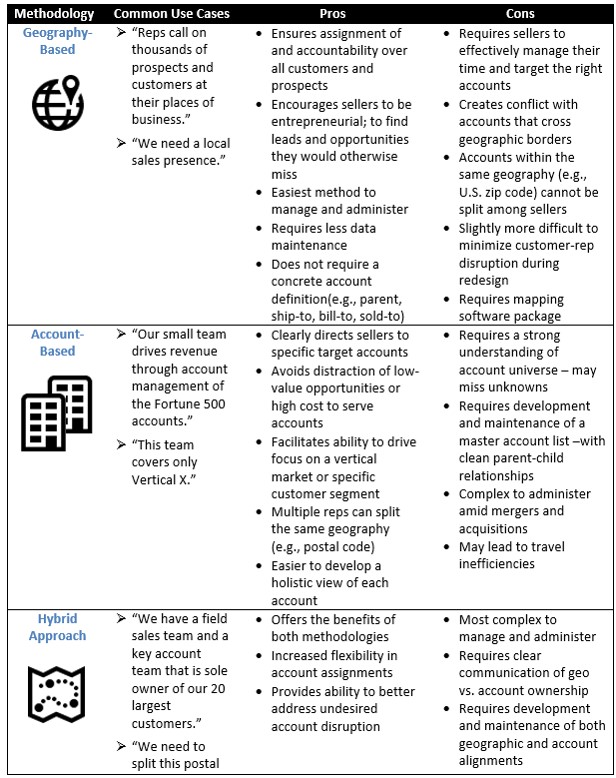Choosing a Territory Design and Alignment Methodology

Should sellers be aligned to a specific geography, a list of named accounts or a combination of both? It’s a simple but important question that sales leaders often overlook in sales deployment discussions. The ultimate decision can have a wide range of downstream impact on the organization; from the seller’s style of territory management to the workload of day-to-day sales operations and administration. Before considering any deployment decisions, it is critical for sales leadership and operations to agree upon the basis and methodology for defining the sales team alignments. The wrong territory alignment methodology can spawn unintended conflict between sales teams and distract sellers from their primary objective – delivering revenue growth.
Common Sales Territory Alignment Methods
The three most common territory alignment methodologies used to define territories include:
- Geography-Based Alignment (most common): territories are defined as a geographic area grouped by postal code, county, area code or state
- Account-Based Alignment: territories consist of a list of named accounts, with little or no regard to geographic location or proximity
- Hybrid of Geo-Based and Account-Based Alignment (most complex): utilizes a combination of geographic and account rules to define territories (e.g., Territory “A” consists of Florida and Georgia with the exception of accounts #112 and #214)
Determining the most effective territory alignment methodology is primarily dependent upon:
- the organization’s go-to-market strategy and structure
- the roles and responsibilities of each sales position
- the organization’s technological capabilities
In some scenarios, the alignment methodology will be obvious. For example, if sellers enter an unknown market and generate new accounts, it’s likely difficult to assign them to a list of target accounts and prospects rather than a geographic territory (e.g., New England). Likewise, if a key account manager is responsible for seven named accounts, it wouldn’t make sense to define their territory as a series of postal codes or counties. But what about when an organization wants sellers to “hunt” within a specific geography while managing a set of named accounts that overlap neighboring geographic territories? The discussion can become complicated rather quickly. Consider the following questions to help guide the decision-making process …
Sales Territory Design Strategy and Structure
- How many unique sales channels, teams and roles are we deploying?
- How do we segment the market? How do we segment our customers?
- What level of coverage do our customers want?
Roles and Responsibilities
- What is the strategic focus of our sellers (e.g., retain customers, grow existing accounts, acquire new customers, drive specific product offerings or support a vertical)?
- What territory planning and management behaviors do we want to promote? What behaviors do we want to avoid?
- How many unique sales individuals will call on a single account? Will any of these teams sell the same product offering(s)?
- How do we want our sales teams to interact?
Technological Capabilities
- How many customers and product SKUs need to be tracked and managed?
- Do our systems support account parent-child relationships? If yes, how clean are the current parent-child relationships?
- How common are account-level exceptions? Is there a need for manual overrides?
- Do we have a geographic mapping or geographic territory design software tool?
The table below provides examples and summarizes the pros and cons of each methodology approach.

While selecting an alignment methodology is a critical step to territory design, it’s only the first of many steps towards a successful sales deployment. The Alexander Group has the experience to guide you through your sales deployment plan and territory design. Please visit the Alexander Group’s Territory Design practice area page to learn more.
Read more articles about Territory Design.
Contact an Alexander Group practice leader.